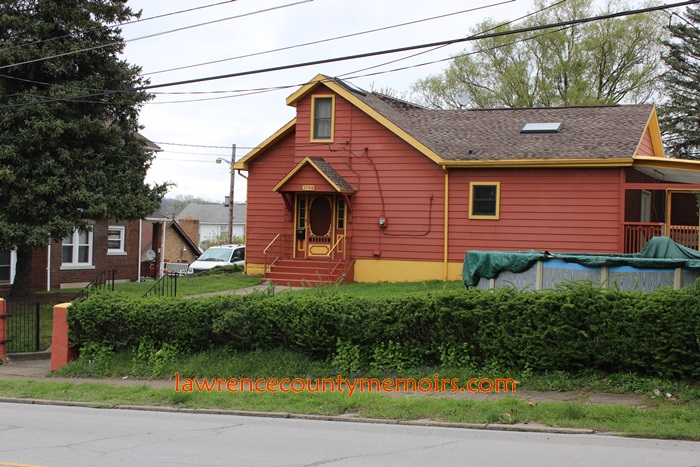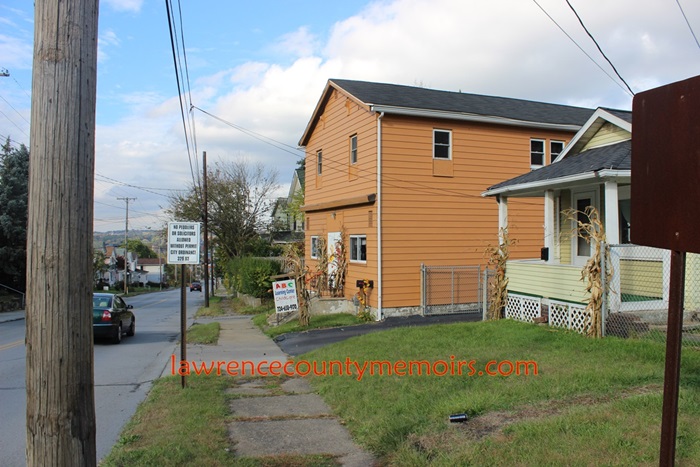In 1909 a small group of immigrants adhering to the Eastern Orthodox Church, mostly hailing from the western reaches of the Russian Empire, began meeting on the South Side of New Castle, Pennsylvania. They mainly included people of Russian heritage, but also other nationalities to include Belarusian, Ukrainian, Lithuanian, Romanian, and Polish. They decided to establish their own church and the Reverend Anthony Doroschuk arrived to help organize their efforts.
The New Castle News of Wednesday, December 10, 1910, reported, “Officials of the Trinity Russian Greek Catholic Orthodox church have, through their solicitor, Rufus C. McKinley, applied for a charter for a church which they plan to erect in New Castle within the next few months. The incorporators are Rev. Anthony Doroshuk, Andrew Hromyak, John Mayher, Peter Brilla, Fedor Sedlavsky, Simon Orobeyko, John Savonevsky and Fedor Litwinovich. A mission has been held for some time, but the congregation has grown to such an extent that a house of worship is necessary.”
The charter was initially denied due to a conflict with the group using the word “Catholic,” when they were not associated with the Roman Catholic Church. The Eastern Orthodox Church had been at odds with the Roman Catholic Church since a schism dating back to the 11th Century. This was essentially a battle between the East and the West – the Greek-speaking Eastern Orthodox (also known as Greek Catholics) against the Latin-speaking Roman Catholics.
The New Castle News of Monday, July 17, 1911, mentioned, “Confirmation of the charter of the Trinity Russian Greek Catholic Orthodox church was withheld. It was held that the incorporators are not connected with the Catholic church and while they may use the word “catholic” as meaning universal, yet as used in the name of this proposed corporation it would convey the idea that the organization is connected with the Roman Catholic church, which is not the case.” The dispute was apparently worked out and a new church (shown above) was built and dedicated on Moravia Street in 1911.
The Reverend Nicholas Koshevich served as rector from 1912 until 1918, followed into and through most of the 1920’s by Stephen Ossipov, Michael Vishegorodzeff, and Policarp “Paul” Chernyavsky. The local people of Russian heritage often worried about how things were going back in the homeland. Russia had been embroiled in a widespread civil war ever since the Russian Revolution of 1917 had ousted Tsar Nicholas II. The economy was wrecked by armed conflict and famine and millions of people faced untold hardships and suffering.
The New Castle News of Monday, October 17, 1921, reported, “Rev. M. Vishegorodzeff, minister of the Russian Orthodox Greek Catholic church, whose residence is at 1714 Moravia street, is heading a movement here to raise funds for Russian Relief work. He has been given permission by Mayor S. A. Barnes (Samuel A. Barnes) to carry on this work in this city. Conditions in Russia are terrible and there is need for immediate relief funds, he says.”
The New Castle congregation became associated with the Russian Orthodox Greek Catholic Church in America (ROGCCA), formed when the American branch of the Russian Orthodox Church declared autonomy in 1924. This was done in response to the Communist takeover of Russia and the confusion of allegiance and control that followed. The ROGCCA went through much subsequent change and in 1970 became the independent Orthodox Church in America (OCA). The Holy Trinity Russian Orthodox Church became a parish under what was usually referred to as the Diocese of Western Pennsylvania, a governing body that eventually the area of Western Pennsylvania, Eastern Ohio, and all of West Virginia.
The Roman Catholic Church made an attempt, albeit unsuccessful, to capitalize on the confusion of the 1920’s to bring the Orthodox Church back into its fold. The New Castle News of Friday, September 18, 1925, carried a national news bulletin that read, “An organized effort by the Roman Catholic church throughout the world to conquer Bolshevism by bringing the Russian Orthodox church back under the Roman standard after 1,000 years of separation, was disclosed today to the National Conference of Catholic Men. Bitterly attacking the “Soviet ecclesiastic monopoly,” Floyd Keeler, field secretary of the Catholic Union, declared Pope Pius was anxious that the followers of the Russian church, oppressed by Communist rule, be rejoined to the older faith.”
It’s likely the New Castle congregation assisted a group of fellow Austro-Hungary immigrants organize the “Holy Trinity Russian Orthodox Greek Catholic Church of Ellwood City” in 1928. The two churches, the newest one located in the area of Ellport, would remain closely associated throughout their histories.
The Reverend Andrew Chernushin took over as rector in 1929, and was succeeded by Paul Chernyavsky when he returned for a second assignment in 1932. It seems the church faced financial difficulties during the tough times of the Great Depression. The New Castle News of Monday, January 21, 1935, listed twenty-two properties seized by the County Sheriff that were to be sold in March 1935. One of them was the church’s parsonage located at the corner of Moravia and Chartes Streets, a two-story house which was being sold for $1,900.
Sadly, the Reverend Chernyavsky, at the age of sixty-three, passed away after a brief illness in November 1938. He was laid to rest in Greenwood Cemetery in New Castle. The small congregation was served by visiting pastors for the next seven years. The Reverend Michael Chanda served as rector for two years starting in 1945, splitting his time between the congregations at New Castle and Ellport.
The experienced Reverend Michael Rusynyk, ordained in 1911, took over in 1947 and the local congregation experienced much growth under his tutelage. The New Castle News of Thursday, May 11, 1950, reported, “A fund raising project has started among parishioners of the Holy Trinity Russian Orthodox church in order to build a new parish house for their priest. Rev. Michael Rusynk, pastor of the church, who is a commuter from Cleveland, O. Rev. Rysynk, whose home is in Cleveland, commutes to New Castle once a week to conduct religious services at the Holy Trinity Russian Orthodox church for a congregation of 45 families.”
Within the next two years the congregation acquired the former Slavish Club Social Hall on Moravia Street. The renamed Russian Orthodox Parish Hall played host to meetings, banquets, dances, and wedding receptions. The upstairs featured two apartments, one of which was apparently utilized by the Reverend Rusynyk. Later that decade the church celebrated its 50th anniversary with a special service held on Sunday, July 26, 1959.
The Reverend Rusynyk, after about forty-nine years of faithful service to the Orthodox cause, retired in 1960 and was succeeded by Alexander Marciniuk, Nikanor Komarnitsky, Constantine Kulmatitsky, and Paul Suda. From 1969 until 1973 the church was without a dedicated rector and was served by a host of part time priests.
The New Castle News of Wednesday, September 24, 1969, reported, “The Rt. Rev. Amvrossy (Merejko), bishop of the Russian Orthodox Archdiocese of Pittsburgh and West Virginia, will officiate at Divine Liturgy commemorating the 60th anniversary of Holy Trinity Russian Orthodox Church Sunday. Bishop Amvrossy, of Pittsburgh, formerly served as bishop in Alaska. He will preside over a Pontifical Divine Liturgy at 10:15 a.m. at the church located on Moravia St…The church has been renovated for the occasion. The interior and exterior have been painted, new carpeting installed and murals were painted on the walls. Holy Trinity Russian Orthodox Church was organized in 1909 and construction of a building was started to satisfy the religious needs. The congregation included newly arrived immigrants of the Russian Orthodox faith and many followers of Greek, Syrian, Romanian and Yugoslavian nationalities.”
The Reverend John G. Sidor, also serving at the Russian Orthodox Church in Ellport, took over as rector in 1973. Sidor, born in the modern-day Slovak Republic, studied theology at the University of Presov and was ordained in 1962. He immigrated to the United States in 1965 and served with several distant parishes before coming to Lawrence County. He would lead the Russian Orthodox congregations at New Castle and Ellport for many years.
The congregation in New Castle apparently decided to downsize, because the parish hall was advertised for sale in 1976. It took a few years to find a buyer but it finally sold in the early 1980’s. The former parish hall was converted into a dance studio, and is currently in use as a day care center. The church building itself was enlarged with a new wing that was dedicated during a ceremony held on Sunday, December 18, 1983. The Bishop Kyrill (Yonchev), in charge of the Diocese of Western Pennsylvania, was on hand to dedicate the new addition. The choir from the Russian Orthodox Church in Ellport provided various musical selections.
Five years later the congregation celebrated its eightieth anniversary. The New Castle News of Saturday, October 7, 1989, reported, “A celebration of the 80th anniversary of the founding of the Holy Trinity Russian Orthodox Church in New Castle will be observed tomorrow. The Hierarchical Divine Liturgy will be celebrated at 10:30 a.m. by His Grace, Bishop Kyrill (Yonchev), assisted by the Rev. John Sidor, pastor of the church and brother clergy.”
In later years the name “Russian” was dropped from the church’s name as the ethnic background of the congregation became more and more intermingled. Due to dwindling attendance the Diocese of Western Pennsylvania ordered the church to be closed down – and it seems this happened by late 1998. The Holy Trinity Orthodox Church on Moravia Street, after being in service for about seventy-eight years, was sold in December 2001 and converted into a private residence. The Reverend Sidor continued to lead the associated congregation at Ellport, although with a greatly reduced congregation, until he retired at the age of eighty-six in August 2015.
 The former Holy Trinity Russian Orthodox Church was sold in late 2001 and converted into a private residence. (Apr 2016) |
 The parish hall on Moravia Street was sold in the early 1980’s. It is currently in use as a day care center. (Oct 2014) Full Size |
 (Oct 2014) |  (Oct 2014) |






Comments
Laura Hromyak Hendrix #
Thank you for putting this up! My Great-Grandfather was Andrew Hromyak, and he was apparently involved with this church. I’m kind of the family historian and I just now found your page! Excited to see this information, as I had found the newspaper article you mentioned.
Jeff Bales (EDITOR) #
(EDITOR’S NOTE) Laura, Glad you found your way here. For updates find the Facebook page of Lawrence County Memoirs and “like” it. Thanks again! Jeff
Comment